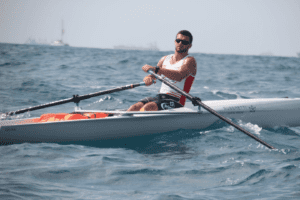Advertisements
Why hasn’t rowing training and equipment raced ahead like other sports (sailing, cycling)? Here is a video with Carlos Dinares’ reflections on the subject.
For what it’s worth, my personal views are
- The conservative people “do what they’ve always done”. This can be frustrating because advances in equipment may only give mili-seconds difference in race results whereas physiologies can make a much bigger difference but take longer to train and develop.
- Many good coaches don’t want to take risks with their training methods and equipment because of the uncertainty of outcomes.
- We find many won’t even try a different oar or scull shape (Dreher rounds) even though we’ve proven they go faster for lightweights and women.
Decide for yourself – or join the conversation by telling us what you think in the comments.
Advertisements









This Post Has 11 Comments
#1 cost. In an already expensive sport, people are reluctant to spend.
#2 where to next. Unlike other sports like cycling, and some sailing classes (among many other sports) having boat minimum weights means the two main design improvements are rigidity and design. Rigidity could be improved, using ceramics perhaps, but there lies the cost component. With respect to design, the best design for a craft that moves between two medium is a long thin cylinder, perfectly round. Oh, hang on, that’s what rowing boats typically are.
Sure, advancements can be made in rowing, bit not with the craft.
Good points. But the manufacturers are always making improvements – did you see the Filippi “self-bailer” eight model? Ingenious.
On equipment surely it’s a risk / reward scenario.
In the 80s there was a saying amongst IT professionals “no one ever got fired for buying IBM”. The logic then is the same as it is in rowing today – no one ever got shot for buying an Empacher (or other tried and tested design and brand)
If you’re investing what are large amounts for a club you can’t afford to make a bad investment (how many clubs could afford to lose the depreciation on a boat from new just to try it…. It’s like buying a car, driving off the forecourt and selling it second hand a day later)
For want of a different phrase you could call this anxietty the purchase “fear factor”. It could be driven by any number of issues such as “is it slower” “will it not be as durable” “will the resale value last” to name a few.
This effect decreases as the cost of the equipment goes down because the impact of a bad purchase choice is less. This is why I think you see more innovation in smaller items… I won’t name the products but various riggers, gates, and rudders are all examples where clubs feel they can risk the experiment and we have seen innovation.
If as a manufacturer or supplier of rowing kit that costs a significant proportion of a club budget (which hence has a big fear factor for a potential buyer) you want to speed the adoption of your kit you need to help people get over their fears that this could be a very costly mistake.
Perhaps someone else could add to the discussion to how rowing manufacturers and suppliers can help buyers past their fear factor
I was under the impression that innovation was discouraged to prevent our sport being dominated by the technology, rather than the skill, strength and fitness of the athletes. If someone built a boat that was, say, 20 seconds quicker over 2000m, everyone would have to scrap their old boats and buy the new one to be competitive.
Interesting that you mention sailing. In (dinghy) sailing, classes of boat are categorised based on how rigid the rules for the class are – from “strict one-design” through to “experimental”. In recent years the stricter classes have been more popular, because they’re simpler and cheaper (in the long term at least) for the owners. The cost of experimentation has gone up with the level of technology available. I suspect that if you opened up a new “experimental” class for, say, single sculls, the experience in rowing would be similar – you wouldn’t get all that many entries, but there’d always be a few die-hards (nutters?) trying things out.
To me, that’s not what it’s all about. It’s not even really about “going as fast as possible” – it’s about testing yourself to see what you’re capable of as an athlete, not as a naval architect. The grass is not always greener on the other side.
In my lifetime the sliding-rigger was indeed outlawed. I believe the motivation was cost. The same for minimum weights. And that’s a good thing. Wouldn’t the world be a better place if shells were more affordable?
Hasn’t anybody noticed that boats today look basically the same as they did in 1850? Not even sliding seats could change hull shapes even a bit. The last innovation that made a real difference was the metal outrigger.
Why? Not because of arbitrary rules stifling innovation. Not because rowers and coaches are afraid to try new stuff. Not because clubs can’t afford better boats. It’s because the rowing shell is one of the most perfect inventions ever devised by the human mind. There’s just not a lot left to improve. Hasn’t been for 160 years.
The safety bicycle, two wheels the same size powered by pedals, a chain and sprocket, is another nearly perfect human design. Rebecca suggested that cycling technology is “racing ahead,” and it is true that bicycles today are lighter, stiffer, better bearings, better gears, better materials . . . and much, much more expensive! Otherwise, they are the same old bike I raced 40 years ago.
In 1967, I bought an absolute top-of-the-line racing bicycle in Rome in 1967 for $100. A similar top-of-the-line bike would cost just about 100 times more today.
In 1972 I bought a top-of-the-line Staempfli single for I forget how much. I’d pay a lot more today, but nowhere near 100 times as much! Nosiree! We are very lucky!
Ned Hanlan rowed a 30-pound single in 1876 that looked and felt and rowed just like the wooden Staempfli I bought 100 years later. The singles of today may be a little stiffer and a little more aerodynamic. The seats slide so well, and the oarlocks are heavenly. It’s a dream to rig a boat anymore. Oars are wonderful, too, these days.
But hasn’t anybody noticed? The rowing’s the same. It’s been the same for nearly 200 years. Just like cycling. But we’re lucky that the prices of boats haven’t risen quite as precipitously as those of bicycles.
I think Peter Mallory got it pretty well right. I believe the hull shape and rigging conformation of a racing skiff approches the ultimate possible. Stiffer lighter materials could be used but at great and increasing expense. If we want our sport to remain a competition between athletes rather than a F1 or America’s Cup style money spending comppetition then let’s keep the restrictive rules we have on weight.
I agree to some extent with Mallory.
Until there’s MONEY in the sport, though, rowing will remain with people rowing pretty much the same boat as everyone else, using pretty much the same oars as everyone else.
Thank goodness boat prices haven’t paralleled bicycle or F1 Auto prices.
However – really – how much room is there for innovation? Some minor tweaking in blade design, a little improvement in the boat/rigger/gate/stretcher/rigging, and the understanding of what’s happening during “technique”. Training – that’s one area where people don’t like innovation because, as another has said, nobody wants to take the chance that the “tried and true” can be improved upon by making a radical change to the volume, intensity, duration (in the year) of the training…
So, they do what they did last year.
And they preach the same technical guff they were taught, even though there are biomechanics and physiology researchers who study the sport. (but – there’s not a lot of money in it – I met someone recently who’s doing research and modelling of blade hydrodynamics, but he’s funding it as an aside from his research on wind turbine aerodynamics.)
W
Peter Mallory comments that the claimed motivation for banning the sliding rigger was cost. The real reason was the significant advantage to boat speed that the sliding rigger provided by smoothing the velocity profile. All other boats would have been obsolete.
The slow pace or lack of innovation in rowing is cultural. Just take a peek at the gauntlet of naysaying gophers that infest RSR. Every time someone discusses an equipment option or tweak, one of the ridiculing rodents pops up to voraciously dispute (or claim patent infringement) the mere possibility that an option could offer something to someone.
Ultimately, tweaks and options ARE the secret to maximizing each individual rower, but the pack demands that proof be shown for all. This is simply not practical, due to the permutations of equipment and the peculiarities of rowers. The ability to measure forces in boats, oars, and through the water, as well as the software to process and deliver real-time feedback offers a path forward, but the ease of use is still in its infancy. Lots of data, little management.
Until some data fluency prevails, those who claim innovations are “myths” are simply spreading more myths of their own. Only room for so many trolls under the bridge, I suppose.
Now…as a product marketer or developer, would you want to stumble into that rodents’ nest? Given that rowing programs also are not keen to spend money? That the sport itself is neglected in media?
Any accountant who doesn’t advise a rowing manufacturer to consider another line of business isn’t fulfilling their fiduciary responsibility.
Hi Rebecca,
Here’s my 2 cents:
Rowing is unique and exceptional – no one who has ever taken up an oar for any length of time would disagree.
At the Olympic level we have three special factors.
First, no significant prize money. We row-and-race for many reasons. Money, by and large, is not one of them. Thus the usual motivation behind steroid/illegal drug use is not present.
Second, we have strict equipment limitations. Thus the cost of a racing single scull, when corrected for inflation, is pretty much the same as it was in 1984.
Third, we don’t thirst after world record times. Conditions from regatta to regatta are simply too variable to compare times.
I pity the poor swimmers. They are ALL about fastest times. When the Speedo LZR Racer was introduced at the Short-course World Championships in 2008, seventeen world records were set. Were the swimmers faster or was the LZR the reason?
Brad